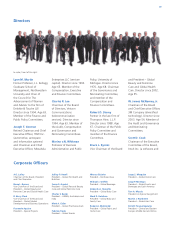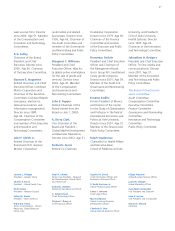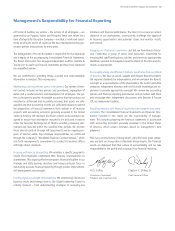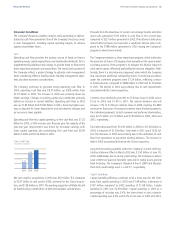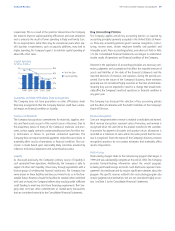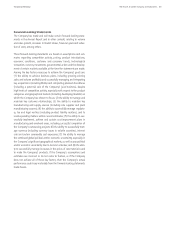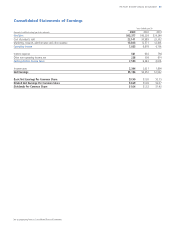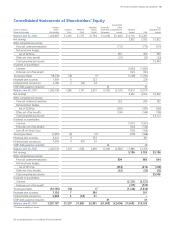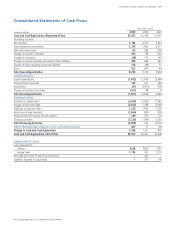Proctor and Gamble 2003 Annual Report Download - page 32
Download and view the complete annual report
Please find page 32 of the 2003 Proctor and Gamble annual report below. You can navigate through the pages in the report by either clicking on the pages listed below, or by using the keyword search tool below to find specific information within the annual report.30Financial Review The Procter & Gamble Company and Subsidiaries
The discount rates used for defined benefit and OPEB plans are set by
benchmarking against investment grade corporate bonds rated AA or
better. The average rate on the defined benefit plans of 5.1% repre-
sents a weighted average of local rates in countries where such plans
exist. A 1% reduction in the discount rate would increase annual bene-
fit expense by approximately $50 million after tax. The rate on the
OPEB plan of 5.8% reflects the higher interest rates generally available
in the U.S., which is where a majority of the plan participants receive
benefits. A 1% reduction in the discount rate would increase annual
benefit expense by approximately $20 million after tax.
Certain defined contribution pension and OPEB benefits in the U.S. are
funded by the Employee Stock Ownership Plan (ESOP), as described in
Note 9 to the Consolidated Financial Statements. The ESOP is account-
ed for under the provisions of the American Institute of Certified Public
Accountants (AICPA) Statement of Position (SOP) No. 76-3,
“Accounting Practices for Certain Employee Stock Ownership Plans.”
Series A shares are used to fund a portion of the defined contribution
plan. Series B shares, used to fund a portion of retiree health care ben-
efits, a component of OPEB, are considered plan assets (net of related
debt) under SFAS No. 106, “Employer’s Accounting for Postretirement
Benefits Other Than Pensions.”
The Company also has employee stock option plans which are account-
ed for under the intrinsic value recognition and measurement provisions
of Accounting Principles Board (APB) Opinion No. 25, “Accounting for
Stock Issued to Employees,” and related interpretations. As stock
options have been issued with exercise prices equal to the market value
of the underlying shares on the grant date, no compensation cost has
resulted. Notes 1 and 8 to the Consolidated Financial Statements pro-
vide supplemental information, including pro forma earnings and earn-
ings per share, as if the Company had accounted for options based
on the fair value method prescribed by SFAS No. 123, “Accounting for
Stock-Based Compensation.” That methodology yields an estimate of
fair value based in part on a number of management estimates, includ-
ing estimated option life and future volatility. Changes in these
assumptions could significantly impact the estimated fair value of the
stock options.
Goodwill and Intangible Assets
The Company has significant goodwill and intangible assets. Manage-
ment’s assessment of the recovery of these assets involves a number of
estimates. The Company tests goodwill and indefinite-lived intangible
assets for impairment at least annually. For intangible assets subject to
amortization, the Company reviews the remaining life of the assets on
an annual basis to determine whether events or circumstances warrant
a revision to the remaining period of amortization. The Company’s
assessments to date have indicated that goodwill and indefinite-
lived intangible assets have not been impaired.
Income Taxes
Under SFAS No. 109, “Accounting for Income Taxes,” income taxes are
recorded based on the current year amounts payable or refundable, as
well as the consequences of events that give rise to deferred tax assets
and liabilities based on differences in how those events are treated for
tax purposes (see Note 10 to the Consolidated Financial Statements).
The Company bases its estimate of deferred tax assets and liabilities on
current tax laws and rates and, in certain cases, business plans and
other expectations about future outcomes.
Changes in existing tax laws and rates, and their related interpretations,
may affect the Company’s ability to successfully manage regulatory
matters around the world, and future business results may affect the
amount of deferred tax liabilities or the valuation of deferred tax assets
over time. The Company’s accounting for deferred tax consequences
represents management’s best estimate of future events that can
be appropriately reflected in the accounting estimates. Certain changes
or future events, such as changes in legislation, tax rates or the
geographic mix of earnings, could have an impact on the Company’s
estimates.
Employee Benefits
The Company sponsors various post-employment benefits throughout
the world. These include pension plans, both defined contribution plans
and defined benefit plans, and other post-employment benefit (OPEB)
plans, consisting primarily of health care and life insurance for retirees.
For accounting purposes, the defined benefit and OPEB plans require
assumptions to estimate the projected and accumulated benefit obliga-
tions, including discount rate, expected salary increases and health care
cost trend rates. These and other assumptions, including the expected
return on plan assets, also affect the annual expense recognized for
these plans.
The expected rates of return on the various defined benefit pension
plans’ assets are based on the asset allocation of each plan and the
long-term projected return of those assets, which represent a diversified
mix of U.S. and international corporate equities and government and
corporate debt securities. For 2003, the average return on assets
assumption is 7.7%. A change in the rate of return of 1% would impact
annual benefit expense by approximately $10 million after tax. The rate
of return on OPEB assets, comprised primarily of Company stock, also is
based on the long-term projected return and reflects the historical pat-
tern of favorable returns on the Company’s stock relative to broader
market indices (e.g., S&P 500). For 2003, the return on assets assump-
tion is 9.5%. A 1% change in the rate of return would impact annual
benefit expense by approximately $20 million after tax.


